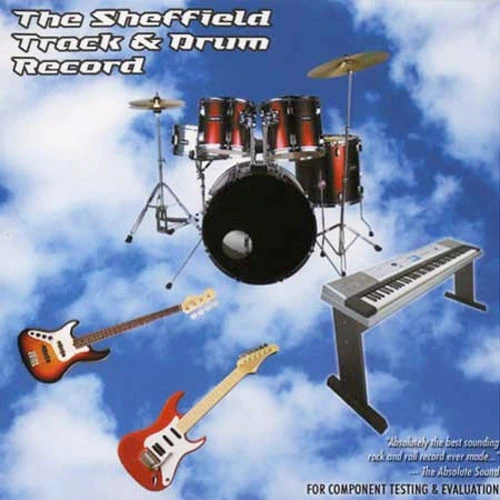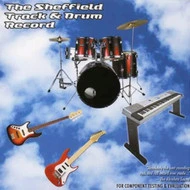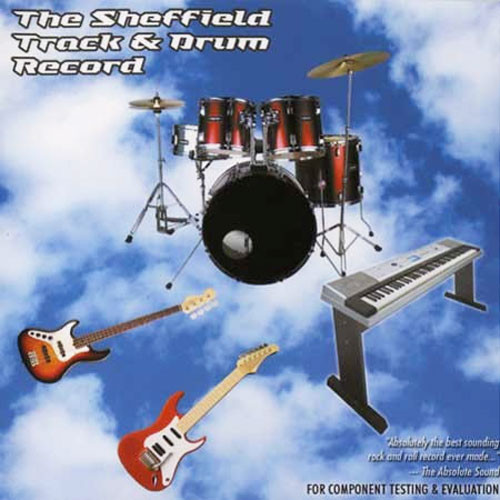Great Sounding Music for Testing and Evaluating Your Sound System!
"Absolutely the best sounding rock and roll record ever made." - The Absolute Sound.
"The sonic fidelity of the Sheffield Drum record is enthralling, and its value for learning about your system makes it a must." - The International Audio Review
"...Unstrained, crystalline clarity ...incredible gut-shaking impact...the sound is beyond belief." -The Sensible Sound
The four rock instrumentals on The Sheffield Drum and Track Record feature Robbie Buchanan and James Newton Howard, keyboards, Lennie Castro, percussion, Nathan East, bass, Mike Landau, guitar, and Carlos Vega, drums. These are followed by two famous drummers, individually, in free solo improvisations. They are Ron Tutt, most well known as Elvis Presley's drummer, and Jim Keltner, former member of Gary Lewis and the Playboys and musical collaborator with John Lennon, George Harrison, Ringo Starr, Bob Dylan and many others.
The Sheffield Drum Record:
(Doug Sax, producer. Bill Schnee, producer, engineer. Lincoln Mayorga, executive producer. Steve Haselton, chief engineer for Sheffield Lab. Recorded December 15 and 17, 1980, Sheffield Lab Studios at MGM, Culver City. California.)
Ron Tutt is one of the most versatile of musicians, admired as both a rock and jazz drummer, and active in recording for television and motion pictures as well as pop records. Ron is best known for the ten years he worked as Elvis Presley's drummer for records and concerts.
Drummer Jim Keltner was an original member of Gary Lewis and The Playboys. Jim participated in many Sheffield recordings, providing the rhythmic propulsion for "Pressure Cooker" and the series of "Distinguished Colleagues" albums. He has recorded with dozens of major artists including John Lennon, George Harrison, Ringo Starr, Bob Dylan, and Bette Midler.
Bill Schnee has earned acclaim both as an engineer and a producer. He has produced albums by such artists as Boz Scaggs and Pablo Cruise. Winner of a Grammy Award for engineering an album by Steely Dan, Bill has also engineered for Barbra Streisand, Ringo Starr, and Carly Simon, and received Grammy nominations for five previous Sheffield Lab recordings.
A drum set is ideal for critical evaluation of a high fidelity system. Sheffield Labs has recorded two extraordinary drummers, individually in free improvisations. this record is a "high resolution test source" and as such is extremely demanding. It will challenge every component in your playback chain. At a reasonable average listening level, some amplifiers may produce clipping, as the peak factors are very great. Adjust your volume accordingly. When comparing different components, Sheffield Labs suggests you try extended listening in addition to rapid "A-B' tests which can sometimes lead you astray.
The microphones used included two overhead mikes which were two feet above the drum set. A third microphone was positioned on the floor in front of the kick drum. On Ron Tutt's drum set an additional fourth microphone was used on his snare drum. His snare is a specifically tuned for rock recording and should sound "thicker" and have less "crack" than the snare used by Jim Keltner. Jim used a concert snare, such as would be used in a symphony orchestra. His snare has incredible impact and a much brighter sound. Listen for the ring off of the room after his snare is hit.
There was no artificial reverberation used to make this record; however you will hear a definite amount of "room decay" in Sheffield Lab's studio, MGM's Stage One, a room designed to record a large orchestra. If yo hear a difference in the amount of "room" between two different components, the one which is giving you more "room" is more accurate. Low level information is the most easily lost in the playback chain as well as being the hardest to capture in the recording room.
The kick drum for both drummers was recorded "well up in the set" to have as much impact as possible. Its wide response is most telling in evaluating transient response and phase linearity of loudspeakers. the microphone was placed to pick up the pat of the beater as well as the low frequency of the drum. Ron's kick drum has more low bottom than Jim's. Played correctly, the kick drum should be "fat" with good impulse and attack, not a "think" sound with mostly attack. Ron's tom-toms, which are wood Ludwigs, are quite even and on the dark side. They are undampened. In certain sections, you will hear one keep ringing after it is hit. A system which allows this ring to be heard and not die off is reproducing what is on the record. Ron's Zildjian cymbals are sweeter sounding with less mid-range and more "silk" than Jim's. They have a preponderance of energy around 8-10khz and will sound a little "hashier" than Ron's.
Jim also plays a whistle, a small sleigh bell which he moves between the overhead mikes, a small rattle, and a triangle which he plays while on the kick drum and high hat. He also creates an unusual effect by scraping the thick end of a drum stick across a symbol. Notice when Jim switches from drum sticks to mallets and brushes.
The accurate reproduction of a drum set is a severe test for all components in a system and will show the advantages of speakers and amplifiers with wide dynamic range the ability to handle transients. J. Peter Moncrieff, editor of the International Audio Review, said, "A woofer can be sluggish or poorly dampened, and you'd never hear anything wrong with a pipe organ pedal note, but a kick drum transient would sound unnatural. 'The Sheffield Drum Record' will tell you about the quality of bass your loudspeaker can put out and will do so within seconds..."
The Sheffield Track Record:
(Bill Schnee, producer, engineer. Doug Sax, executive producer. Recorded May 22, 1982, Sheffield Lab Studios at MGM, Culver City, California.)
The Sheffield Track Record is designed to test the capabilities of a sound system. Producer/engineer Bill Schnee sought first to capture the instruments that are the foundation of rock music, the drum set and the electric bass. This underpinning supports guitars, keyboards, and other elements that are the instrumental ingredients in a rock and roll record. A stereo system which reproduces the impact, low end transients, percussive clarity, dynamic and frequency ranges of "The Sheffield Track Record", is capable of handling the demands of most any recording, be it rock, pop, jazz, or classical.
The four basic elements in rock-oriented pop music are bass, drums, guitar, and keyboard. Engineers, producers, and studio musicians all agree that for sheer impact and exhilarating energy, these basic accompaniment instruments, which are usually recorded on separate tracks, considerably surpass the "final" record which is the end product of compromised audio quality due to overdubbing, mix-down, and editing.
For this project, Bill Schnee assembled a group of the most in demand musicians in the Los Angeles recording studios, instrumentalists for whom rock is a natural language, bringing great musical interest to the record. Highlights of the recording are the two original compositions by James Newton Howard and Robbie Buchanan, "Amuseum" and "Le Ballade", both with appealing melodies that lent themselves to the complete arrangements heard here.
"The Sheffield Track Record" is not only a tool for the evaluation of a sound system, but a musical statement that will stand the test of time.
Mastering Engineer's note:
This analogue disc was played back with a Technics SP 15 turntable and a Shure V15 Type V assembly attached to a SME 3012R arm. The pre-amp consisted of a pair of refurbished Marantz Audio Consolettes set to the RIAA Curve. The analogue signal was converted to a 96kHz 24-bit PCM signal using a Lucid A/D converter. The digital signal was then processed using the phase corrector, Declickle and De-crackle modules of Cedar's Cambridge restoration suite, and then loaded into the Sadie Disc Editor, where Cedar's Retouch Plugin was employed to remove unwanted noise. The assembled master was sampled to a 44.1kHz 24-bit PCM signal, and dithered to a 16-bit PCM signal for CD mastering using the Power 3 algorithm.
MADO Mastered from Analogue Disc Originals! These musical performances were originally recorded live to analogue disc and transferred to digital fro this CD release. Optimization of all mechanical elements in playback was achieved before digital processing. The listener will experience an immediacy and presence that is unique, the closets one can get to the original live source.
Features:
CD
2007 Remaster featuring NEW artwork!
Mastered from Analogue Disc Originals!
Musicians:
Drum Record:
Ron Tutt, drums
Jim Keltner, drums
Track Record:
Robbie Buchanan, James Newton Howard, keyboards
Lennie Castro, percussion
Nathan East, bass
Mike Landau, guitar
Carlos Vega, drums
Selections:
The Basic Tracks
1. Amuseum
2. The Higher You Rise
3. Wise To The Lines
4. Le Ballade
The Basic Drummers
Free Improvisations
5. Ron Tutt
6. Jim Keltner
"Absolutely the best sounding rock and roll record ever made." - The Absolute Sound.
"The sonic fidelity of the Sheffield Drum record is enthralling, and its value for learning about your system makes it a must." - The International Audio Review
"...Unstrained, crystalline clarity ...incredible gut-shaking impact...the sound is beyond belief." -The Sensible Sound
The four rock instrumentals on The Sheffield Drum and Track Record feature Robbie Buchanan and James Newton Howard, keyboards, Lennie Castro, percussion, Nathan East, bass, Mike Landau, guitar, and Carlos Vega, drums. These are followed by two famous drummers, individually, in free solo improvisations. They are Ron Tutt, most well known as Elvis Presley's drummer, and Jim Keltner, former member of Gary Lewis and the Playboys and musical collaborator with John Lennon, George Harrison, Ringo Starr, Bob Dylan and many others.
The Sheffield Drum Record:
(Doug Sax, producer. Bill Schnee, producer, engineer. Lincoln Mayorga, executive producer. Steve Haselton, chief engineer for Sheffield Lab. Recorded December 15 and 17, 1980, Sheffield Lab Studios at MGM, Culver City. California.)
Ron Tutt is one of the most versatile of musicians, admired as both a rock and jazz drummer, and active in recording for television and motion pictures as well as pop records. Ron is best known for the ten years he worked as Elvis Presley's drummer for records and concerts.
Drummer Jim Keltner was an original member of Gary Lewis and The Playboys. Jim participated in many Sheffield recordings, providing the rhythmic propulsion for "Pressure Cooker" and the series of "Distinguished Colleagues" albums. He has recorded with dozens of major artists including John Lennon, George Harrison, Ringo Starr, Bob Dylan, and Bette Midler.
Bill Schnee has earned acclaim both as an engineer and a producer. He has produced albums by such artists as Boz Scaggs and Pablo Cruise. Winner of a Grammy Award for engineering an album by Steely Dan, Bill has also engineered for Barbra Streisand, Ringo Starr, and Carly Simon, and received Grammy nominations for five previous Sheffield Lab recordings.
A drum set is ideal for critical evaluation of a high fidelity system. Sheffield Labs has recorded two extraordinary drummers, individually in free improvisations. this record is a "high resolution test source" and as such is extremely demanding. It will challenge every component in your playback chain. At a reasonable average listening level, some amplifiers may produce clipping, as the peak factors are very great. Adjust your volume accordingly. When comparing different components, Sheffield Labs suggests you try extended listening in addition to rapid "A-B' tests which can sometimes lead you astray.
The microphones used included two overhead mikes which were two feet above the drum set. A third microphone was positioned on the floor in front of the kick drum. On Ron Tutt's drum set an additional fourth microphone was used on his snare drum. His snare is a specifically tuned for rock recording and should sound "thicker" and have less "crack" than the snare used by Jim Keltner. Jim used a concert snare, such as would be used in a symphony orchestra. His snare has incredible impact and a much brighter sound. Listen for the ring off of the room after his snare is hit.
There was no artificial reverberation used to make this record; however you will hear a definite amount of "room decay" in Sheffield Lab's studio, MGM's Stage One, a room designed to record a large orchestra. If yo hear a difference in the amount of "room" between two different components, the one which is giving you more "room" is more accurate. Low level information is the most easily lost in the playback chain as well as being the hardest to capture in the recording room.
The kick drum for both drummers was recorded "well up in the set" to have as much impact as possible. Its wide response is most telling in evaluating transient response and phase linearity of loudspeakers. the microphone was placed to pick up the pat of the beater as well as the low frequency of the drum. Ron's kick drum has more low bottom than Jim's. Played correctly, the kick drum should be "fat" with good impulse and attack, not a "think" sound with mostly attack. Ron's tom-toms, which are wood Ludwigs, are quite even and on the dark side. They are undampened. In certain sections, you will hear one keep ringing after it is hit. A system which allows this ring to be heard and not die off is reproducing what is on the record. Ron's Zildjian cymbals are sweeter sounding with less mid-range and more "silk" than Jim's. They have a preponderance of energy around 8-10khz and will sound a little "hashier" than Ron's.
Jim also plays a whistle, a small sleigh bell which he moves between the overhead mikes, a small rattle, and a triangle which he plays while on the kick drum and high hat. He also creates an unusual effect by scraping the thick end of a drum stick across a symbol. Notice when Jim switches from drum sticks to mallets and brushes.
The accurate reproduction of a drum set is a severe test for all components in a system and will show the advantages of speakers and amplifiers with wide dynamic range the ability to handle transients. J. Peter Moncrieff, editor of the International Audio Review, said, "A woofer can be sluggish or poorly dampened, and you'd never hear anything wrong with a pipe organ pedal note, but a kick drum transient would sound unnatural. 'The Sheffield Drum Record' will tell you about the quality of bass your loudspeaker can put out and will do so within seconds..."
The Sheffield Track Record:
(Bill Schnee, producer, engineer. Doug Sax, executive producer. Recorded May 22, 1982, Sheffield Lab Studios at MGM, Culver City, California.)
The Sheffield Track Record is designed to test the capabilities of a sound system. Producer/engineer Bill Schnee sought first to capture the instruments that are the foundation of rock music, the drum set and the electric bass. This underpinning supports guitars, keyboards, and other elements that are the instrumental ingredients in a rock and roll record. A stereo system which reproduces the impact, low end transients, percussive clarity, dynamic and frequency ranges of "The Sheffield Track Record", is capable of handling the demands of most any recording, be it rock, pop, jazz, or classical.
The four basic elements in rock-oriented pop music are bass, drums, guitar, and keyboard. Engineers, producers, and studio musicians all agree that for sheer impact and exhilarating energy, these basic accompaniment instruments, which are usually recorded on separate tracks, considerably surpass the "final" record which is the end product of compromised audio quality due to overdubbing, mix-down, and editing.
For this project, Bill Schnee assembled a group of the most in demand musicians in the Los Angeles recording studios, instrumentalists for whom rock is a natural language, bringing great musical interest to the record. Highlights of the recording are the two original compositions by James Newton Howard and Robbie Buchanan, "Amuseum" and "Le Ballade", both with appealing melodies that lent themselves to the complete arrangements heard here.
"The Sheffield Track Record" is not only a tool for the evaluation of a sound system, but a musical statement that will stand the test of time.
Mastering Engineer's note:
This analogue disc was played back with a Technics SP 15 turntable and a Shure V15 Type V assembly attached to a SME 3012R arm. The pre-amp consisted of a pair of refurbished Marantz Audio Consolettes set to the RIAA Curve. The analogue signal was converted to a 96kHz 24-bit PCM signal using a Lucid A/D converter. The digital signal was then processed using the phase corrector, Declickle and De-crackle modules of Cedar's Cambridge restoration suite, and then loaded into the Sadie Disc Editor, where Cedar's Retouch Plugin was employed to remove unwanted noise. The assembled master was sampled to a 44.1kHz 24-bit PCM signal, and dithered to a 16-bit PCM signal for CD mastering using the Power 3 algorithm.
MADO Mastered from Analogue Disc Originals! These musical performances were originally recorded live to analogue disc and transferred to digital fro this CD release. Optimization of all mechanical elements in playback was achieved before digital processing. The listener will experience an immediacy and presence that is unique, the closets one can get to the original live source.
Features:
CD
2007 Remaster featuring NEW artwork!
Mastered from Analogue Disc Originals!
Musicians:
Drum Record:
Ron Tutt, drums
Jim Keltner, drums
Track Record:
Robbie Buchanan, James Newton Howard, keyboards
Lennie Castro, percussion
Nathan East, bass
Mike Landau, guitar
Carlos Vega, drums
Selections:
The Basic Tracks
1. Amuseum
2. The Higher You Rise
3. Wise To The Lines
4. Le Ballade
The Basic Drummers
Free Improvisations
5. Ron Tutt
6. Jim Keltner


 Turntable Accessories
Turntable Accessories Headphone Accessories
Headphone Accessories Cable Accessories
Cable Accessories Vinyl Accessories
Vinyl Accessories Compact Disc Accessories
Compact Disc Accessories









